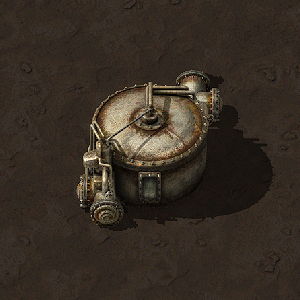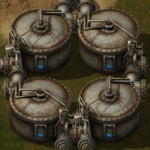Storage tank: Difference between revisions
m (indented and italicized see also link) |
(→Usage: Little rewrites for clarity and readability) |
||
| Line 6: | Line 6: | ||
== Usage == | == Usage == | ||
Storage tanks will only be filled to the same percentage of capacity as pipes that lead to it. | Storage tanks will only be filled to the same percentage of capacity as pipes that lead to it. A pipe that carries about 50 water will fill the tank to about 50% of its capacity. [[Pump]]s can be used to fill the entire tank from a low pressure source (such as distant [[pumpjack]]s). | ||
The storage tank is | The storage tank is often used to store raw materials and excess products from [[Oil processing]], allowing a [[oil refinery|refinery]] to run without interruptions. It can also be connected to the [[circuit network]], sending the fluid contents as a signal to the network. | ||
The storage tank can be emptied by ''mining and rebuilding it'' (the fluid is destroyed) or by draining it with a [[pump]]. | The storage tank can be emptied by ''mining and rebuilding it'' (the fluid is destroyed) or by draining it with a [[pump]]. | ||
Revision as of 18:31, 23 August 2018
| Storage tank |
|
Recipe |
|
| + + → | |
|
Total raw |
|
| + + |
|
Map color |
|
|
Fluid storage volume |
25000 |
|
Health |
500 |
|
Stack size |
50 |
|
Dimensions |
3×3 |
|
Mining time |
0.5 |
|
Prototype type |
|
|
Internal name |
storage-tank |
|
Required technologies |
|
|
Produced by |
|
|
Consumed by |
|
The storage tank is a building that can store up to 25,000 units of a fluid. It is a passive storage—it has no input and no output, depending on pressure to fill it, essentially being a large pipe.
Usage
Storage tanks will only be filled to the same percentage of capacity as pipes that lead to it. A pipe that carries about 50 water will fill the tank to about 50% of its capacity. Pumps can be used to fill the entire tank from a low pressure source (such as distant pumpjacks).
The storage tank is often used to store raw materials and excess products from Oil processing, allowing a refinery to run without interruptions. It can also be connected to the circuit network, sending the fluid contents as a signal to the network.
The storage tank can be emptied by mining and rebuilding it (the fluid is destroyed) or by draining it with a pump.
Usage as "Energy-tank"
- See also: Steam tanks as power storage
Storage tanks can also be used as a replacement for accumulators. If steam consumption by steam engines or turbines changes a lot over a daily cycle (for example due to solar panels or laser turrets), storage tanks can be filled with steam during low power usage and then emptied during heavy load.
A storage tank filled with heat exchanger 500°C steam stores around 2.4GJ; a storage tank filled with boiler 165°C steam stores 750MJ.
Calculations
- 1 Storage tank can store 25,000 units of 500ºC steam.
- 1 Steam turbine can output 5,820kW = 5,820kJ/s using 60 units of 500ºC steam/s.
- 1 Storage tank can keep 1 steam turbine working at full capacity for 25,000 ∕ 60 ≈ 416.6667s
- A Storage tank can store up to 25,000 ∕ 60 × 5,820 = 2,425,000kJ using 500ºC steam.
- 1 Storage tank can store 25,000 units of 165ºC steam.
- 1 Steam engine can output 900kW = 900kJ/s using 30 units of 165ºC steam/s.
- 1 Storage tank can keep 1 steam engine working for 25,000 ∕ 30 ≈ 833.3333s
- A Storage tank can store up to 25,000 ∕ 30 × 900 = 750,000kJ using 165ºC steam.
History
- 0.15.0:
- Multiplied all fluid amounts by 10.
- 0.13.12:
- Fluid icon now scales with size of tank.
- 0.12.0:
- Liquid inside can be seen through a small window.
- Now connectible to the circuit network.
- 0.9.1:
- Now has double capacity and takes longer to mine.
- 0.9.0:
- Introduced

